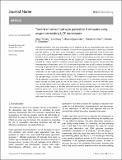Toward enhanced hydrogen generation from water using oxygen permeating LCF membranes
Author(s)
Chang, Le; Uddi, Mruthunjaya; Kirchen, Patrick; Ghoniem, Ahmed F.; Wu, Xiaoyu
DownloadGhoniem_Toward enhanced hydrogen generation from water using oxygen permeating LCF membranes.pdf (1.653Mb)
OPEN_ACCESS_POLICY
Open Access Policy
Creative Commons Attribution-Noncommercial-Share Alike
Terms of use
Metadata
Show full item recordAbstract
Hydrogen production from water thermolysis can be enhanced by the use of perovskite-type mixed ionic and electronic conducting (MIEC) membranes, through which oxygen permeation is driven by a chemical potential gradient. In this work, water thermolysis experiments were performed using 0.9 mm thick La[subscript 0.9]Ca[subscript 0.1]FeO[subscript 3−δ] (LCF-91) perovskite membranes at 990 °C in a lab-scale button-cell reactor. We examined the effects of the operating conditions such as the gas species concentrations and flow rates on the feed and sweep sides on the water thermolysis rate and oxygen flux. A single step reaction mechanism is proposed for surface reactions, and three-resistance permeation models are derived. Results show that water thermolysis is facilitated by the LCF-91 membrane especially when a fuel is added to the sweep gas. Increasing the gas flow rate and water concentration on the feed side or the hydrogen concentration on the sweep side enhances the hydrogen production rate. In this work, hydrogen is used as the fuel by construction, so that a single-step surface reaction mechanism can be developed and water thermolysis rate parameters can be derived. Both surface reaction rate parameters for oxygen incorporation/dissociation and hydrogen–oxygen reactions are fitted at 990 °C. We compare the oxygen fluxes in water thermolysis and air separation experiments, and identify different limiting steps in the processes involving various oxygen sources and sweep gases for this 0.9 mm thick LCF-91 membrane. In the air feed-inert sweep case, the bulk diffusion and sweep side surface reaction are the two limiting steps. In the water feed-inert sweep case, surface reaction on the feed side dominates the oxygen permeation process. Yet in the water feed-fuel sweep case, surface reactions on both the feed and sweep sides are rate determining when hydrogen concentration in the sweep side is in the range of 1–5 vol%. Furthermore, long term studies show that the surface morphology changes and silica impurities have little impact on the oxygen flux for either water thermolysis or air separation.
Date issued
2015-03Department
Massachusetts Institute of Technology. Department of Mechanical EngineeringJournal
Physical Chemistry Chemical Physics
Publisher
Royal Society of Chemistry
Citation
Wu, Xiao-Yu, Le Chang, Mruthunjaya Uddi, Patrick Kirchen, and Ahmed F. Ghoniem. “Toward Enhanced Hydrogen Generation from Water Using Oxygen Permeating LCF Membranes.” Phys. Chem. Chem. Phys. 17, no. 15 (2015): 10093–10107.
Version: Author's final manuscript
ISSN
1463-9076
1463-9084